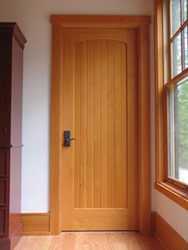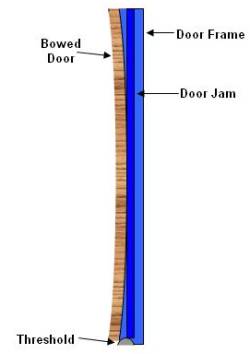
Figure 1 - Interior solid wood door
One of the most common mistakes made, even by professional door installers, is not sealing the edges of the door after it has been trimmed or sanded to fit.
This is most common on top and bottom edges of doors that are not visible after the door has been hung.
It is very important, in order to prevent the door from absorbing moisture from the air and bowing, as shown in Figure 2, warping or expanding to have all the edges of the door sealed with a varnish, urethane, shellac, stain or paint. The most common result of not sealing the edges of an exterior door is bowing, where the top and bottom of the door no longer close tightly to the threshold on the bottom or the door frame on the top.

Figure 2 - Bowed door
Solution for a sticky door:
- Check the screws in the door hinges and ensure that they are snug before starting to sand door edges. Screws do loosen and this in itself can create a sticky door.

Figure 3 - Powdered chalk
- Using chalk, dust the inside edge of the door frame. Note: If the surface of the door frame is painted, make sure you purchase water soluble chalk that can be removed with soap and water. Powdered chalk (Figure 3) that is made for chalk lines is inexpensive and works well.
- Close the door, the chalk will have transferred to the edge of the door in the areas where the door is sticking against the door frame.
- Remove the door by popping the hinge bolts, it is generally not necessary to remove the hinges.
- Using a sander, the best sander for this application is a belt sander, however a pad sander will work, sand down the areas that have the chalk transferred to them.It is best to remove small quantities of material, you can always remove more if the door still sticks, you cannot replace the material if you have sanded down to much and left a large gap.
- Replace the door and check it's fit.If necessary repeat the chalking and sanding process, until you are happy with the overall fit of the door.
- The area that has been sanded should be coated with a shellac, varnish, urethane, stain or paint to prevent moisture from entering.
If the sticky door is a seasonal issue, it sticks in the summer but not in the winter, sanding or trimming the door to prevent it from sticking in one season will mean that the door will have a larger gap between the frame and the door edge when the door is closed during the season when it doesn't stick.
